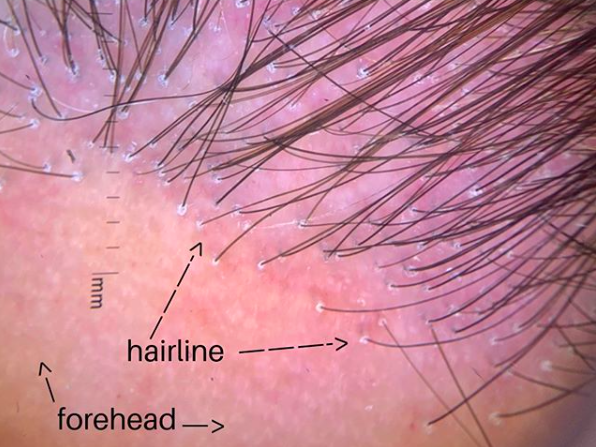Frontal Fibrosing Alopecia and Rosacea: What is the link? Who is predisposed?
Rosacea in FFA Patients Linked to Greater Scalp inflammation, Greater Body Mass and Lower progesterone Levels
Several studies to date have suggested an association between the frontal fibrosing alopecia (FFA) and the common dermatologic condition known as acne rosacea (or simply “rosacea”). How exactly the two are linked is not entirely clear.
Typical trichoscopic image of a patient with the scarring alopecia known as frontal fibrosing alopecia or “FFA.” There are most single hairs in the frontal hair line and the vellus hairs are not seen. There is scale around some hairs and also redness.
Moreno-Arrones and colleagues recently conducted a multicentre case-control study and recruited 335 individuals with FFA and 329 patients who did not have FFA. Women with FFA were found to have a nearly two fold greater incidence of rosacea compared to women without FFA (OR = 1.91; 95% CI 1.07-3.39). Porriño-Bustamante and colleagues also recently performed their own cross sectional study which included 99 women with frontal fibrosing alopecia and 40 controls. 62 % of women with FFA had rosacea compares to 30% of women without FFA. Women with more advanced stages of FFA were the most likely to report having rosacea compared with women with less advanced stages.
For women with FFA, three factors were found to be associated with a higher chance of having rosacea. In order of importance, these appeared to be 1) perifollicular erythema on the scalp 2) low serum progesterone levels and 3) higher body mass index.
Women with FFA are most likely to report having a diagnosis of rosacea. However, what needs to be understood is whether FFA associated rosacea is precisely the same as rosacea in the general population. Inflammation of the small vellus hairs of the face is known to be a part of FFA but is not so much a feature of typical rosacea in the same way. Pindado-Ortega showed in 2018 that most patients who were diagnosed with rosacea (28 of 35) ended up having the so called erythematotelangiectatic subtype of rosacea and 7 of the 35 had the so called papulopustular subtype. For now, rosacea in FFA is viewed as the same as rosacea in the general population. More studies will clarify the precise etiology.
References
Moreno-Arrones OM, et al. Clin Exp Dermatol. 2019.
Pindado-Ortega C, et al. J Am Acad Dermatol. 2018.
Walker JL, et al. Skinmed. 2016.
Porriño-Bustamante ML, et al. Acta Derm Venereol. 2019.
This article was written by Dr. Jeff Donovan, a Canadian and US board certified dermatologist specializing exclusively in hair loss.

